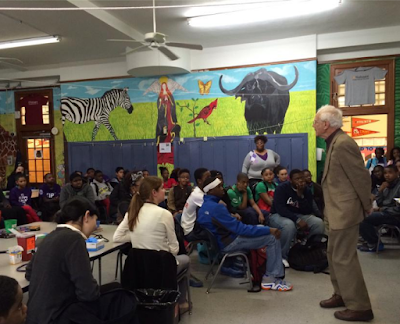Asthma and Allergies in St. Louis City
| St. Louis Gateway Arch From Eads Bridge by Matthew Black |
In 2009, the Asthma and Allergy Foundation of America named St. Louis as their Asthma Capital, making it the worst city in America for someone with asthma to live. While our ranking has dropped some (now we sit at 26th for Asthma and 25th for allergies), it’s not because our air has gotten any better; it’s merely because other cities have gotten worse. As a St. Louis city resident, knowing what asthma and allergies are, how they affect St. Louis, what groups are particularly susceptible to them, and how they can be treated is very important.
Allergies are diseases where the body’s immune system misidentifies allergens as potentially harmful substances and produces an immune response. This immune response can be triggered by a plethora of allergens like pollen, mold, pet dander, foods, medications, or plants. When these allergens trigger an allergic response, common symptoms include coughing, sneezing, itching, wheezing, congestion, even rashes and hives. Asthma is a chronic disease of the lungs in which the inner walls of your airways become inflamed which leads to shortness of breath, coughing, chest tightness and wheezing. During an asthma attack, airway linings inflame, swell, become clogged with mucus, and the muscles around the area tighten. When this occurs, breathing can become difficult, often described as trying to breathe through a straw that has been filled with cotton balls.
In St. Louis City, children’s asthma rates are twice the national average and asthma death rates are three times the average. There are a couple of factors that contribute to these awful statistics. First of all, St. Louis City is situated between two large rivers, so pollen and mold are highly prevalent. St. Louis air is also polluted by the fact that the city is lacking in smoke-free laws and the smoking rate is 19% greater than the country average. Smoking can aggravate the respiratory system of people suffering from asthma and allergies, leading to poor health outcomes. The final piece of the puzzle in the picture of St. Louis’ poor air is the fact that we do not have as many lung specialists as we need to be able to deal with all of the problems our poor air quality creates.
| SLU Asthma and Allergy Clinic |
However, there’s a chronic lack of access to quality healthcare in inner-city neighborhoods. Residents cannot get the regular medical care that is imperative for controlling asthma and allergies and often have to rely only on emergency room visits when the situation gets especially bad. Luckily for St. Louis City residents, St. Louis University School of Medicine is determined to help everyone get the medical treatment they need to combat these harmful diseases. They opened a free clinic that deals specifically with asthma and allergies and is run by Dr. Ray Slavin and SLU medical students.
It’s open every other Wednesday and is located at 1408 N Kingshighway Blvd, Suite 213, Saint Louis, MO 63113. For more information please visit: https://sites.google.com/a/slu.edu/health-resources-center-saint-louis-university-school-of-medicine/asthma-and-allergy-clinic
 |
| Dr. Slavin speaking to St. Louis children about asthma |
References:
African Americans and Asthma in Missouri. (n.d.). Retrieved September 9, 2015.
Asthma and Allergy Foundation of America - Information About Asthma, Allergies, Food Allergies and More! (n.d.). Retrieved September 13, 2015.
Baruchin, A. (2007, August 28). For Minority Kids, No Room to Breathe. Retrieved September 10, 2015.
Black, M. (2007, September 22). St. Louis Gateway Arch From Eads Bridge. Retrieved September 20, 2015.
Black, M. (2007, September 22). St. Louis Gateway Arch From Eads Bridge. Retrieved September 20, 2015.
Green, E. (2012, December 14). The Makings of an Asthma Epidemic in St. Louis. Retrieved September 9, 2015.

5 Comments:
did not know asthma effects so many in the city
Didn't know it was that bad in Saint Louis! I'm glad the school was able to open a free clinic
This is why I dont care too much for STL and the neighboring towns. I know by edwardsville, we are 20 minutes from wood river and Alton which both have oil mines! Kids will look at the sky and think its clouds but its really smoke, and lots of it! Pollution isnt a joke people!
I'm shocked to learn how bad it is in St. Louis!
I know living in polluted cities doesn't help asthma, but I didn't know that St. Louis was the worst a few years ago. It's unsettling to think about the air quality of cities who have taken its place.
This is really well written and really well organized. I've lived in St. Louis all my life and still had no idea that this problem was so bad! This topic would definitely interest a lot of St. Louis residents who suffer from asthma and allergens, as well as those who were thinking of going into that field. They could really make a difference in such a city.
My only recommendation is that you make a catchier title. In this era of internet-dominance, it's getting harder and harder to get people to click on your link unless it's catchy (hence, click-bait). Otherwise, very interesting article.
Post a Comment
Subscribe to Post Comments [Atom]
<< Home